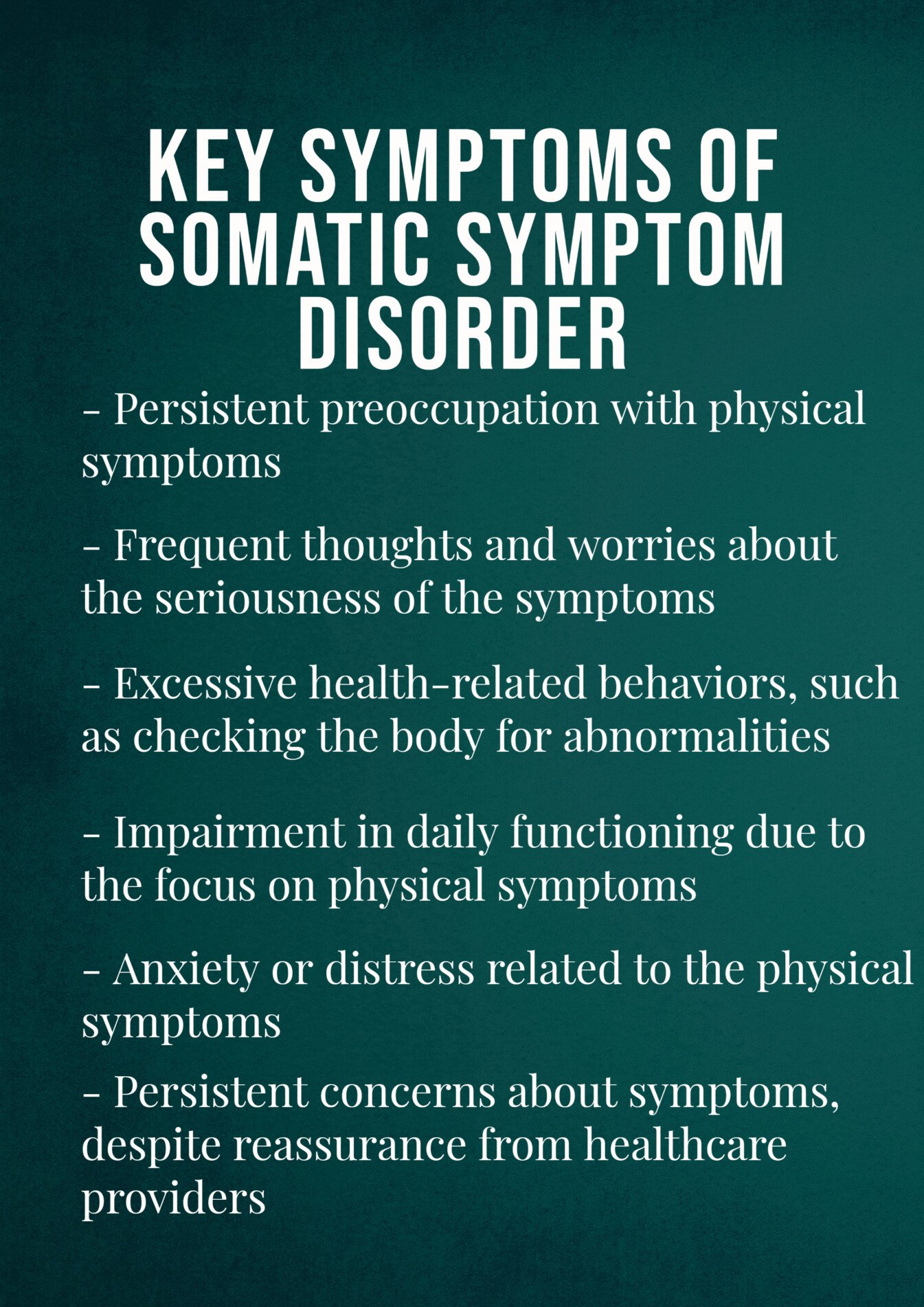On This Page:
Somatoform disorders involve physical symptoms suggesting illness or injury that any medical condition cannot fully explain. Symptoms are real and cause significant distress or impairment, but psychological factors like stress or trauma are likely involved in their manifestation.
Key Points
- Somatization is the expression of mental experiences into physical responses. Somatic symptom disorder (SSD) is a psychiatric disorder characterized by an obsession with unexplained physical symptoms, commonly physical pain, which cannot be explained by medical disorders.
- SDD affects roughly 7% percent of adults in the US. While SDD is more commonly seen in women, individuals with a preexisting mental health condition or family history of SDD are at increased risk of developing the disorder.
- SDD imparts significant distress and challenge to the patient and the physician.

What is Somatic Symptom Disorder?
Somatic symptom disorder is a psychological condition characterized by a persistent preoccupation with physical symptoms, such as pain, weakness, or shortness of breath, that causes significant distress and impairment in daily functioning.
It is diagnosed when an individual experiences excessive thoughts, feelings, and behaviors related to their physical symptoms, often leading to frequent doctor visits and medical tests.
Somatic symptom disorder is a term introduced in the DSM-5 to replace somatization disorder and hypochondriasis.
Somatic symptom disorder (SSD) falls under the umbrella of somatoform disorders. Somatoform disorders are disorders in which thoughts, actions, and emotions correlate to somatic symptoms. The DSM-5 outlines seven main variations of Somatoform disorders as follows:
- Somatization disorder
- Conversion disorder
- Pain disorder
- Hypochondriasis
- Other specified somatic symptoms and related disorder
- Unspecified somatic symptoms and related disorder
In SDD, a person has an excessive preoccupation with physical symptoms, such as pain, weakness, or shortness of breath, which impairs optimal daily functioning.
Oftentimes patients have disproportionate amounts of anxiety correlated to their physical symptoms.
These physical symptoms may or may not be associated with an underlying medical condition. In SDD, individuals may experience excessive thoughts, feelings, and behaviors relating to the symptoms, making them believe they are sick.
These patients frequently seek care and continue to search for an explanation for their symptoms even when other serious conditions have been excluded.
Risk Factors
Factors that make a person more at risk of having somatic symptom disorder include:
- Previous history of anxiety and depression
- Having a medical condition, recovering from one, or having a strong family history of a medical condition
- Stressful life experiences, such as trauma, violence, child abuse, sexual abuse, etc
- Poor socioeconomic status and low education level
Symptoms

Physical Symptoms
- Pain in any area of the body
- Pain during sexual activity or menstruation
- Headaches
- Fatigue
- Dizziness
- Fainting
- Weakness
- Constipation
- Diarrhea
- Digestive issues
- Breathing difficulties
Behavioral Symptoms
- Excessive preoccupation with physical symptoms
- Physical health concerns are the main focus in life
- Constantly visiting physician
- Reporting normal sensations or discomfort to the physician due to catastrophizing the symptom
- Irrationally worrying about medical conditions that have been ruled out
- Dissatisfied with health treatment and assuming that the physician is not taking you seriously
- Sensitive to the side effects of drugs
Emotional Symptoms
- Intrusive thoughts about physical symptoms
- Feeling anxious
- Seek to be taken care of
- Depression
- Fear and anxiety, even when they are shown evidence of no serious illness.
Diagnosis
To be diagnosed with SDD, a person must exhibit one of the following criteria:
- One or more physical symptoms disturb and disrupt the normal functioning of daily life.
- Excessive thoughts, feelings, and behaviors related to physical symptoms (such as ongoing thoughts that are out of proportion to the seriousness of symptoms, ongoing high levels of anxiety, and excessive time/energy spent on health concerns).
- Although symptoms may be different, at least one of them must be constant, and symptoms may come and go.
Treatment Options
The main aim of treatment is to enhance a person’s daily functioning by reducing their physical symptoms or improving their ability to cope. The plan usually consists of medication, psychotherapy, or hypnosis.
If left untreated, somatic symptom disorder can lead to poor health, problems functioning in daily life, physical disability, relationship problems, work problem, and unemployment.
Other complications may include co-occurring mental health disorders, such as anxiety, depression, and personality disorders, and increased suicide risk related to depression.
These individuals also face financial problems due to recurrent healthcare visits and excessive medication usage.
Medication
In case of a co-occurring condition, such as anxiety or depression, antidepressant medications may be used.
These medications alone cannot resolve somatic symptoms, but they help alleviate the symptoms of associated co-occurring conditions, particularly when combined with psychotherapy.
Psychotherapy
Cognitive-behavioral therapy (CBT) is the most commonly used treatment option focused on helping people better manage their thoughts and behaviors.
CBT can help them learn how to decrease their preoccupation with their symptoms and engage more optimally in their daily routine.
Hypnosis
Hypnosis is a systematic procedure conducted by a trained psychotherapist during which a person, responding to suggestions, experiences changes in memory, perception, and/or voluntary action.
Hypnosis is effective in pain relief, the most frequently reported symptom in those struggling with SDD.
When to see a doctor
Somatic symptom disorder affects the daily life of many individuals, and you should contact your healthcare provider if you feel so concerned about physical symptoms that you can’t function or if you have symptoms of anxiety or depression.
The doctor will evaluate you accordingly and will ensure proper treatment according to the symptoms and underlying cause.
Co-occurring conditions associated with Somatic Symptom Disorder (SSD)
SDD often co-occurs with psychological disorders such as anxiety and depression, which may be the cause of SDD. It is crucial for these conditions to be addressed for optimal recovery.
To cope with the uncomfortable feelings associated with SDD, many individuals may turn to drugs and alcohol hence why substance abuse is a common co-occurring condition in SDD.
SDD vs. Illness Anxiety Disorder
Illness anxiety disorder (IAD), previously known as hypochondriasis, is the obsession with the idea of being ill. It does not typically involve any somatic symptoms, but individuals complain about having a medical illness.
In contrast, SDD is characterized by at least one specific somatic symptom causing significant disruption in one’s life.
IAD is the focus on an illness, while SDD is the focus on a specific symptom.
According to the DSM-5, two types of patients fall under illness anxiety disorder, the care-seeking ones and the care-avoidant ones.
Both SDD and IAD are preoccupied with a medical illness, but in SDD, there is a somatic expression of the complaint. Illness anxiety disorder is dominated by anxiety about acquiring a serious medical illness.
Both cases are characterized by frequent doctor visits and increased worry and anxiety due to failure to diagnose.
SDD vs. Conversion Disorder
Conversion disorder, also known as Functional Neurological Symptom Disorder, is a psychological condition in which patients present involuntary neurological symptoms which do not fit any neurological disorder.
An example of this is pseudo seizures, in which a person displays signs of convulsions or jerking that match a seizure, yet there is no abnormal EEG activity.
The term conversion disorder was developed by Sigmund Freud, who believed that neurological symptoms arise from repressed psychological conflict.
Conversion disorder differs from somatic symptom disorder in that patients are disturbed by physical consequences.
In SDD, symptoms are usually catastrophized, and much of the impairment to daily functioning results from the emotional consequences.
Further Information
References
Diagnostic and statistical manual of mental disorders: DSM-5. (5th ed.). (2013). American Psychiatric Association.
Frances, A. (2013). The new somatic symptom disorder in DSM-5 risks mislabeling many people as mentally ill. Bmj, 346 .
French, J. H., & Hameed, S. (2021). Illness Anxiety Disorder . In StatPearls. StatPearls Publishing.
Hasin, D., & Katz, H. (2007). Somatoform and substance use disorders. Psychosomatic Medicine, 69 (9), 870–875.
Henningsen P. (2018). Management of somatic symptom disorder. Dialogues in Clinical Neuroscience, 20 (1), 23–31.
Hurwitz T. A. (2004). Somatization and conversion disorder. Canadian journal of psychiatry. Revue canadienne de psychiatrie, 49 (3), 172–178.
Kallivayalil, R. A., & Punnoose, V. P. (2010). Understanding and managing somatoform disorders: Making sense of non-sense. Indian journal of psychiatry, 52 (Suppl 1), S240–S245.
Kurlansik, S. L., & Maffei, M. S. (2016). Somatic Symptom Disorder. American family physician, 93 (1), 49–54.
Thompson, T., Terhune, D. B., Oram, C., Sharangparni, J., Rouf, R., Solmi, M., Veronese, N., & Stubbs, B. (2019). The effectiveness of hypnosis for pain relief: A systematic review and meta-analysis of 85 controlled experimental trials. Neuroscience and biobehavioral reviews, 99, 298–310.


